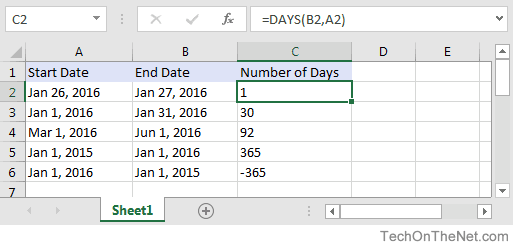DATEDIF function
※ Download: Datedif excel 2016
Les informations recueillies sont destinées à CCM Benchmark Group pour vous assurer l'envoi de votre newsletter. For reasons unknown, it is only documented in Excel 2000, but it works in all Excel versions since that time.

When you enter a date, then use the General format, it displays as an Excel serial number. I tested it with 2016 and 2010 Version and both had the same strange behaviour. I tested it with 2016 and 2010 Version and both had the same strange behaviour.

DATEDIF function - YM The difference between the months days and years are ignored.

DATEDIF , which means Date + Dif, is a compatibility function left over from Lotus 1-2-3 that Microsoft adopted in Excel version 2000, which is the only version that explains how this function works. The purpose of this function is to calculate the time between a user-specified starting and ending date in days, months, or years. Date formats You can enter dates for this formula four different ways: 1. When you enter a date, then use the General format, it displays as an Excel serial number. The result for this formula is four months. JD Sartain Note: Excel cannot calculate dates before January 1, 1900 on Windows PCs, and January 1, 1904 on Apple Mac systems. As cell references: that is, you can point to or enter the cell address. The result of this formula is 397 days. As text strings: that is, dates inside of quotation marks. You can enter the date in any format you like. Note, however, that if you enter the month and day with no year, Excel assumes the current year. The result of this formula is three full years. Or, as a response to other functions such as the TODAY function or the NOW function. For example, how many days between NOW and Christmas? The answer is 70 days. Note : Remember, when using the NOW or TODAY function, the answer changes every day. So, if you open this spreadsheet tomorrow, the answer will be one day fewer. JD Sartain Rounding results up or down 1. The DATEDIF function always rounds down by default to the nearest whole month or year. The result is now rounded up to the nearest month or year. JD Sartain Nesting DATEDIF functions 1. You can also nest the DATEDIF function, combine it with other Excel functions such as TODAY and NOW , such as above, or nest it within itself to get all three arguments—the number of years, months, and days. The answer is 5 years, 8 months, 22 days. If the date is hard-coded into the formula, you have to open up and edit each formula one at a time. And when you copy a hard-coded formula, you end up with the same date in each of the copied cells. The answer at the time I made this spreadsheet a few months ago is 60 years, 11 months, and 3 days, and of course if I opened this spreadsheet today, it would be a longer time. JD Sartain For additional information regarding DATEDIF functions, start with this Microsoft Office , or search online, or find a packrat friend who still has the Microsoft Excel 2000 reference manual.
It could refer to a piece of hardware. See the known issues section below. I can get the IF formula to work on blank cells if I put the age in manually as a number but not if I use the result from the DATEDIF cell. Note, however, that if you enter the month and day with no year, Excel assumes the current year. It creates it using the year in cell E17, and the month in cell E17. If this parameter is omitted, it assumes that the week containing Jan 1st is the first week of the year. JD Sartain Rounding results up or datedif excel 2016 1. Elles seront également utilisées sous réserve des options souscrites, à des fins de ciblage publicitaire. I have tried using the but it won't work on the cell with the DATEDIF formula as a value.



